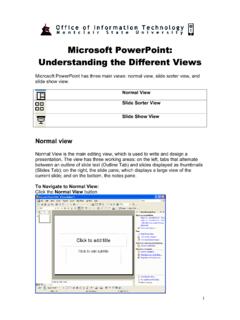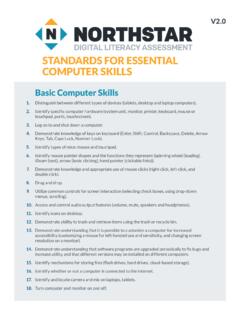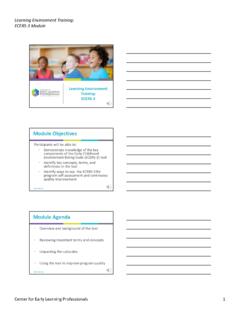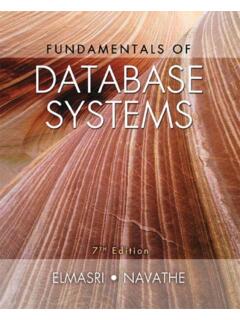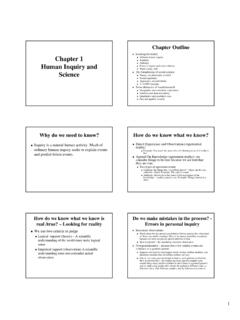Transcription of Excel 2019 Data Analysis - tcworkshop.com
1 The Computer Workshop, 2019 Data AnalysisLesson NotesExcel 2019 Data AnalysisCourse Number: 0200-405-19-WCourse Release Number: 1 Software Release Number: 20195/6/2020 Developed by:Brian Ireson Suzanne Hixon Thelma TippieEdited by:Jeffery DeRamusCheri HowardPublished by:RoundTown Publishing5131 Post Road, Suite 102 Dublin, Ohio 43017forThe Computer Workshop, Upper Metro Place, Suite 140 Dublin, Ohio 43017(614) 798-9505 Copyright 2020 by RoundTown Publishing. No reproduction or transmittal of any part of this publication, in any form or by any means, mechanical or electronic, including photocopying, recording, storage in an information retrieval system, or otherwise, is permitted without the prior consent of RoundTown :Round Town Publishing produced this manual with great care to make it of good quality and accurate, and therefore, provides no warranties for this publication whatsoever, including, but not limited to, the implied warranties of merchantability or fitness for specific uses.
2 Changes may be made to this document without Notices:The Computer Workshop, Inc. and The Computer Workshop logo are registered trademarks of The Computer Workshop, Inc. [Microsoft], [Windows], [PowerPoint], [ Excel ], [Word], and [Access] are registered trademarks of Microsoft Corporation. [Photoshop] and [InDesign] are a registered trademark of Adobe. All other product names and services identified throughout this book are trademarks or registered trademarks of their respective companies. All NASA information was obtained from public resources. Using any of these trade names is for editorial purposes only and in no way is intended to convey endorsement or other affiliation with this iv Excel 2019: Data Analysis , Rel. 1, 5/6/2020 Lesson 1: TablesTables ..3 Creating a Table ..4 Using Home Tab ..4 Using the Insert Tab ..5 Using the Quick Analysis Components ..10 Records and Fields ..14 Resizing A Table ..15 Using the Resize Handle.
3 15 Resizing a Table Using the Design Ribbon ..15 Adding Fields ..17 Using the Right Click Insert Menu ..17By Selecting an Adjacent the Ribbon ..18 Adding Records ..19 Adding Records Inside the Table ..19 Adding Records at the End of the Table ..19 Deleting Records or Fields ..20 The Total Row ..25 Adding a Total the Total Row ..26 Using the QAT to Create a Total Row ..26 Data Forms ..28 Adding the Form Tool to the QAT ..28 Using a Form to Enter Records ..29 Slicers ..32 Adding Slicers to a the Slicer ..33 Using the Slicer ..33 Clearing a Slicer Filter ..34 Closing or Deleting a Slicer ..34 Lesson 2: Importing DataImporting Data from other sources ..39 Using Excel and Access ..40 Creating a Table from an Access Object ..41 Using the Data Ribbon ..41 Setting the Refresh Properties ..42 Importing Data Using the Microsoft Query Connection 46 Setting up a Querry Connection ..46 Importing Data from a Text A Text File in Excel .
4 55 Importing a Text file into a Workbook ..58 Table of ContentsExcel 2019: Data Analysis , Rel. 1, 5/6/2020 Page vPrefaceLesson 3: Data ManagementUnderstanding Structured Data ..65 Guidelines for Data Structure ..65 Cleaning Up Raw Data ..65 Removing Blank Rows ..66 Removing Blank Rows ..66 Removing Duplicates ..69 Remove Duplicates ..69 Conditional Formatting ..72 Using Conditional Formatting To Find Duplicates ..72 Comparing Two Lists With Conditional Formatting .73 Sorting Data ..77 Applying a Simple Sort ..77 Basic Sorting in a Table ..78 Sorting on Multiple Fields ..81 Flash Fill ..85 Flash Fill to Combine or Separate Data ..85 AutoFilters ..89 Basic Filtering ..89 Custom AutoFilters ..92 Creating a Custom AutoFilter ..92 Using the Search Feature ..94 Using Wildcards ..94 Clearing Filters ..95 Advanced Filter ..97 Using an Advanced Filter ..97 Clearing the Filter ..98 Copying Filtered Records ..99 Copying Filtered Records to a New Location.
5 99 Lesson 4: Database FunctionsDatabase Functions ..105 Basic Syntax of D-Functions ..107 Creating a D-Function Formula ..108 Entering the Function Manually ..109 Expanding D-Functions ..114 Adding Drop-down Menu's ..116 Data Validation of Contents,continuedPrefacePage vi Excel 2019: Data Analysis , Rel. 1, 5/6/2020 Lesson 5: Data ModelingData Modeling ..123 Enabling Power Pivot ..123 understanding Relationships ..126 Relational Databases ..126 Preparing the Tables ..127 Structuring the Data ..127 Convert the Data to a Table ..127 Rename the Table ..127 Creating Relationships ..129 Find the Related Data ..129 Creating Relationships ..129 Managing the Data Model ..133To Open Excel 's Power Pivot window ..133 Power Pivot Views ..134 Adding a New Connection ..136 Creating PivotTables ..138 Creating PivotTables ..138 Working with a PivotTable ..140 Adding a Calculated Column ..145 Inserting a Function of Contents,continuedPrefacePage vii Excel 2019: Data Analysis , Rel.
6 1, 5/6/2020 Welcome to the Advanced Excel 2013 course. This manual and the data files are designed to be used for learning, review and reference after the class. The data files can be downloaded any time from The Computer Workshop website: http:\\ is no login or password required to access these files. You will also find handouts and supplementary materials on the website in the Download Download Data FilesOnce on The Computer Workshops website, look at the bottom of any page to find the link Download. Clicking this link opens the Download page where you can choose either Data Files or Handouts. 1. Data Files opens a list of general application types. 2. Click once on the Microsoft Office Courses Click once on the software related to the Click once on the version related to the If there are multiple folders, click on the TCW Click on the course name to download the data can choose to open or save the zipped folders content to your computer.
7 The handouts are in PDF format and also available to you without login or password. Simply open the PDF and either print or save to your this ManualPrefacePage viii Excel 2019: Data Analysis , Rel. 1, 5/6/2020 Conventions Used in this ManualThe hands-on exercises (Actions) are written in a two-column format. The left column ( Instructions ) gives numbered instructions, such as what to type, keys to press, commands to choose from menus, etc. The right column ( Results/Comments ), contains comments describing results of, reasons for, quick keys, etc. for the instructions listed on the left. Key names and Functions are bold and enclosed in square brackets: [Enter], [Tab], [F5], [F10] Keys you press simultaneously are separated by a plus (+) sign, typed in bold and enclosed in square brackets. You do not press the plus. [Shift + F5] Keys you press in sequence are separated by a space, bold and enclosed in square brackets.
8 [Home] [Down Arrow] Ribbon tab names are in bold and italic: Example: Home Group names are in bold: Example: Font Dialog box names are in italic: Example: Save As Button names are bold and enclosed in square brackets: Example: [Sort] Information you are to type will be in bold. Example:This is the first day of the rest of your life. Information that you need to supply will be indicated with pointed brackets. Example: Type: <your name>. ConventionsLesson OverviewYou will cover the following concepts in this chapter:Lesson 1: Tables & Data ManagementExcel 2019: Data AnalysisRel. , 5/6/2020 Data Management Locating Blanks Removing Blank Rows Removing Duplicates Combining Cell Values Splitting Cell Values Flash Fill Tables Creating a Table Autofilters Advanced Filter Data FormsLesson NotesExcel 2019: Data Analysis , Rel. , 5/6/2020 Page 3 Lesson 1: Tables & Data ManagementUnderstanding Structured DataWhile data in Excel can be laid out in many different ways some analytical features require the data be in a specific structure.
9 As an example: creating tables, sorting, and /or filtering data will not work properly if there are gaps in the data. Since Excel recognizes adjacent rows and columns of data as a dataset, a blank row or column indicates the end of the data set, which can give partial views of the complete data set. Guidelines for Data Structure Only one row of labels for the header row. Each column contains only one type of data. Continuous rows and columns of data; no gaps and no decorative rows or columns. Break data down into the smallest value necessary for sorting or filtering. An address should be broken down into columns Address | Appt | City | State | Zip Each row of data represents only one record. A spreadsheet containing a list of employees personal information, one employee per row. No duplicate rows of Up Raw DataBefore you are able to begin working with data, it may be necessary to ensure there are no problems within the data.
10 Excel offers several tools to speed this process up significantly; duplicate removal, splitting combined elements into component data, and combining data into new columns of required information. It is a good idea to quickly check for and correct possible issues early on to avoid issues further down the ManagementLesson 1: Tables & Data Management Page 4 Excel 2019: Data Analysis , Rel. , 5/6/2020 Locating BlanksWhile removing blank rows can be easily managed, you may need to see where the blanks are before removing the entire row. This can be done for an individual column or the entire data set by using the Conditional Formatting Formatting Blanks Select the column or data set to be searched. On the Home Tab in the Styles Group, click the [Conditional Formatting] button drop-down. Choose New from the menu. The New Formatting Rule dialog opens. From the list of Rule Type, select Format only cells that contain.
